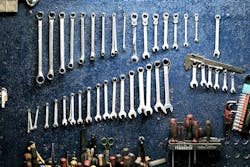Safety in the Shop: Guiding in the Vehicles
It happens a hundred times a day in each and every lube shop in the country. Technicians driving or guiding vehicles into the service bays and then back out again. It can become so routine and so repetitive that complacency starts to creep in, and when it does, accidents happen.
Customers vs. Employees
When it comes to bringing cars into and out of service bays, there are two kinds of shops: those that have their customers drive the cars in and those who do the driving themselves. You’d think practice would make perfect and that lube shops that do their own driving would enjoy a lower accident rate. However, the reality is there’s no appreciable difference in the number of accidents no matter which system a shop uses. How can this be? The smart money is on employees getting a little too comfortable in their jobs and not paying as much attention as they should. Just one moment of distraction or inattention can cause an expensive and potentially dangerous accident. The good news is, with clear communication most safety concerns will be prevented. The bad news is, poor communication is the cause of most accidents.
Proper Procedure
If your shop lets the customers do the driving, then it’s essential your employees are guiding them in safely. No one should ever be in front of a car or truck while it’s on its way in or out, even if it’s stopped and the engine is running. All it takes is one flustered driver to step on the gas pedal instead of the brake to injure an employee, damage the vehicle or service bay, or something even worse.
Safely positioned to the driver’s side of the car, technicians should give clear hand signals at should height and/or clear and concise verbal directions. Employees should make eye contact with drivers and make sure they are tracking with the instructions they’re given. You may even want to consider adding markings on the floor to help drivers place their vehicles properly. Lube shop workers should never assume customers know how far to pull in or how to align the vehicle over the pit or lift. It may seem simple enough to experienced oil change techs, but just do a YouTube search for oil change accidents, and you’ll quickly learn otherwise.
Furthermore, it’s important each and every customer has a positive experience when they visit the shop. Unclear instruction, having to back up and reposition or unfriendly or impatient employees may seem like small inconveniences, but they may add up to someone opting not to come back.
Keeping It Professional
While the primary reason for making sure cars are properly guided into the shop is safety, and preventing costly accidents is a close second, there’s a third reason this seemingly routine operation is so important. It’s the impression it makes on customers. Pulling into the bay, or watching a shop employee drive it in, is the oil and lube business’ first chance to make a good impression.
Driving into a service bay, for example, can be an intimidating and confusing experience for customers. Putting them at ease with clear instructions and a friendly face should be a high priority for every employee. It is, perhaps, even more important to be consummately professional if customers are handing over their keys to let shop workers do the driving. Chances are, the owner is watching every move their car makes on its way into the bay, hoping their ride is in good hands. Building trust is the best way to ensure people who bring their cars to your shop will do so more than once or twice. Something as small as having to back a car up and try again while driving it into the bay can give the impression the employee doesn’t really know what he or she is doing.
In short, the more professional the employees and the smoother things are run, the more impressed and at ease a customer will be. Since most people only have to get their oil changed a handful of times each year, it’s important that every time they come in they have a positive experience. Lube techs and managers should treat each customer as if it’s their first time coming in, even if they’ve come dozens of times before.
As with many things in life, the devil is in the details. Something as mundane as moving cars in and out of the service bays can make a big difference in the customer’s experience, employees’ safety and, indirectly, to the business’ overall success.
